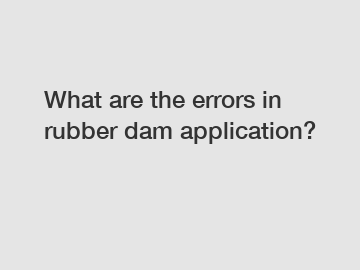Feb. 05, 2024
Environment
What are the errors in rubber dam application? Rubber dam application is a common technique used in dentistry to isolate the operating field, enhance visibility, and improve infection control during dental procedures. However, certain errors in the application of rubber dam can compromise its effectiveness and result in suboptimal outcomes.
One of the errors commonly observed in rubber dam application is improper isolation. This can occur when the dam is not properly stretched, resulting in gaps between the tooth and the dam. As a result, saliva and oral fluids can contaminate the operating field, obstructing the dentist's view and compromising infection control. To address this error, it is crucial to ensure that the rubber dam is stretched adequately and securely fitted around the tooth, leaving no gaps for fluid leakage.
Another error is the incorrect placement of the dental clamp. Dental clamps are used to secure the rubber dam in place and provide stability during the procedure. However, if the clamp is positioned improperly, it can cause discomfort for the patient, damage the tooth structure, or obstruct access to the treatment area. Dentists should carefully evaluate the tooth anatomy and select the appropriate clamp before placement to avoid such errors.

Moreover, inadequate dam thickness can also impact the effectiveness of rubber dam application. A thin dam may tear easily during placement, compromising its ability to isolate the operating field and maintain a dry environment. It is important for dentists to select a thick, durable dam that can withstand the forces exerted during the procedure.
The significance of avoiding these errors in rubber dam application lies in the impact it has on treatment outcomes. Proper isolation of the operating field ensures improved visibility, enabling more accurate and precise dental procedures. It also minimizes the risk of contamination, reducing the likelihood of infections and post-operative complications. Additionally, the use of rubber dam enhances patient comfort by preventing contact between dental materials and oral tissues, such as the tongue and cheeks.
To prevent these errors, dentists should receive adequate training and continuously update their knowledge and skills in rubber dam application. Dental schools and continuing education courses should emphasize the importance of proper technique and provide hands-on training opportunities. Additionally, the use of rubber dam should be encouraged and supported by dental professionals to promote its widespread adoption and enhance the quality of dental care.
In conclusion, errors in rubber dam application can compromise the effectiveness of this technique. Improper isolation, incorrect clamp placement, and inadequate dam thickness are some common errors to be addressed. The proper application of rubber dam is crucial for optimal treatment outcomes, infection control, and patient comfort. Continued education and training in proper technique are important to minimize these errors and improve the overall quality of dental care.
If you are looking for more details, kindly visit Air Inflatable Rubber Dam, inflatable rubber dam for Bangladesh, Stainless Steel Hydraulic Elevator Dam.
Previous: What is opto electronic packaging?
Next: Where can I order the top-rated oil activated carbon filter element in Denmark?
If you are interested in sending in a Guest Blogger Submission,welcome to write for us!
All Comments ( 0 )